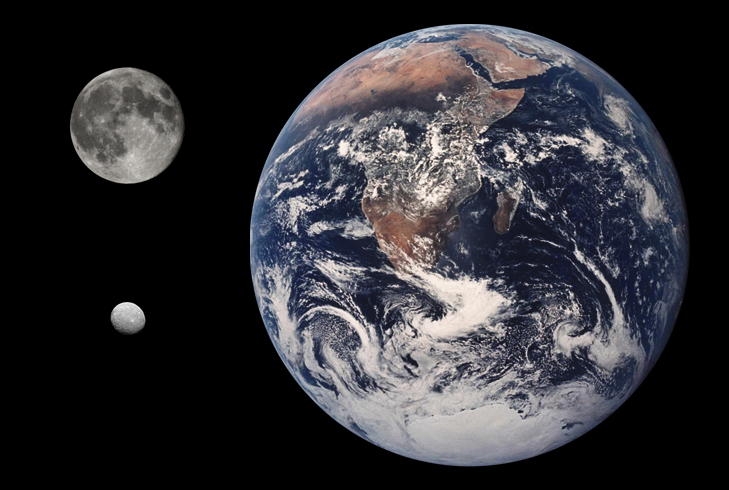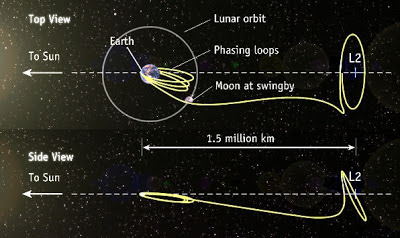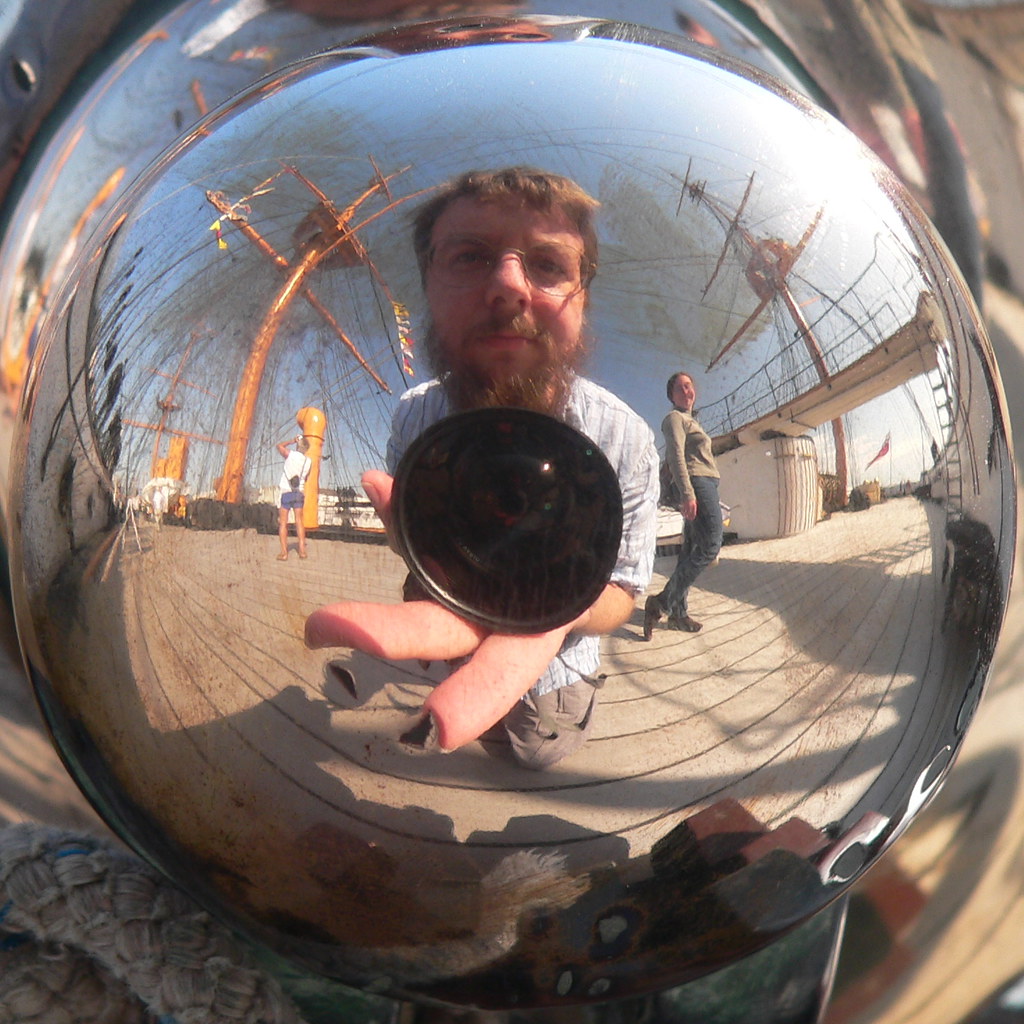Sunday, March 31, 2013
Easter Egg Hunt
We went back out to the house one last time for the kids to say goodbye to the place and for an Easter egg hunt! (more soon...)
Last (Minute) Repairs
We have been working every available moment fixing up the rental house before we officially move out...
In addition to cleaning and moving out our stuff there are a few repairs we have been making. One of the doors had a hole in it. (One of the kids locked themselves in a room, couldn't get out, and was upset, ... ) We temporarily had a poster up over the hole but this is our responsibility to fix. So V bought a new door and I chiseled out spaces to recess the hinges, got that hooked up, then V painted it to match the old door color.
Another door had a crack in it that was smaller. At first V tried to spackle it but it wouldn't hold. So she sawed out a square, sprayed foam inside, put epoxy on top of that and spackle on top of the epoxy layer, sanded it down, and now it is ready to paint.
We also went around and patched and painted various small holes from hanging pictures and bolting furniture to the wall.
Finally, the top was broken on one of the toilets. (An arm of a shelf support mounted on the wall above the toilet collapsed and the shelf board speared through the top porcelain lid of the tank.) It was a small kid sized toilet (in the master bathroom...?) and we couldn't find the same size replacement so we just replaced the whole thing with a normal sized toilet.
I have also been cutting the grass around the house whenever I get the chance. The landlord has been showing up at random times and fussing about the grass (she said we "let it die" and ruined the back yard, but there is more grass there now than when we started--I have pictures and we talked to neighbors who agreed to write letters about the condition of the yard when we moved in, which our landlord commented on at the time). I am worried about a showdown with her; once we told her we were moving her attitude completely flipped. She did not show up at our meeting to walk through the house for a final check. She marked out our names on mail in our mailbox and wrote "VACANT" next to the address (we are still paying rent for the house, still occupying it, and I am pretty sure it is illegal for her to mess with our mail). And she has been showing up without warning (she is supposed to give 24 hours notice) walking around the house without announcing herself, and doing strange things like peering in the windows and turning the water on and off (which we are paying for) on the outside faucets.
Another issue is the carpet in the living and dining rooms. It was old and stained when we moved in and she offered to buy new carpet. I asked her to wait until we moved out because we have young kids and this way we don't have to worry about them spilling anything or marking on the carpet. Now she is saying the carpet was perfect when we moved in and that we have ruined it... Again, I am going through my old pictures to see if I can find ones showing the condition of the carpet.
I could go on about other details with the window blinds, kitchen stove, refrigerator, erosion under the house, the front door, wiring... but I don't want to. I am glad we are moving out.
In addition to cleaning and moving out our stuff there are a few repairs we have been making. One of the doors had a hole in it. (One of the kids locked themselves in a room, couldn't get out, and was upset, ... ) We temporarily had a poster up over the hole but this is our responsibility to fix. So V bought a new door and I chiseled out spaces to recess the hinges, got that hooked up, then V painted it to match the old door color.
Another door had a crack in it that was smaller. At first V tried to spackle it but it wouldn't hold. So she sawed out a square, sprayed foam inside, put epoxy on top of that and spackle on top of the epoxy layer, sanded it down, and now it is ready to paint.
We also went around and patched and painted various small holes from hanging pictures and bolting furniture to the wall.
Finally, the top was broken on one of the toilets. (An arm of a shelf support mounted on the wall above the toilet collapsed and the shelf board speared through the top porcelain lid of the tank.) It was a small kid sized toilet (in the master bathroom...?) and we couldn't find the same size replacement so we just replaced the whole thing with a normal sized toilet.
I have also been cutting the grass around the house whenever I get the chance. The landlord has been showing up at random times and fussing about the grass (she said we "let it die" and ruined the back yard, but there is more grass there now than when we started--I have pictures and we talked to neighbors who agreed to write letters about the condition of the yard when we moved in, which our landlord commented on at the time). I am worried about a showdown with her; once we told her we were moving her attitude completely flipped. She did not show up at our meeting to walk through the house for a final check. She marked out our names on mail in our mailbox and wrote "VACANT" next to the address (we are still paying rent for the house, still occupying it, and I am pretty sure it is illegal for her to mess with our mail). And she has been showing up without warning (she is supposed to give 24 hours notice) walking around the house without announcing herself, and doing strange things like peering in the windows and turning the water on and off (which we are paying for) on the outside faucets.
Another issue is the carpet in the living and dining rooms. It was old and stained when we moved in and she offered to buy new carpet. I asked her to wait until we moved out because we have young kids and this way we don't have to worry about them spilling anything or marking on the carpet. Now she is saying the carpet was perfect when we moved in and that we have ruined it... Again, I am going through my old pictures to see if I can find ones showing the condition of the carpet.
I could go on about other details with the window blinds, kitchen stove, refrigerator, erosion under the house, the front door, wiring... but I don't want to. I am glad we are moving out.
Sunday, March 24, 2013
Moving ... again
Sorry, I haven't posted in a while. Long story short, an opportunity came up for a cheaper apartment closer to where we work, but we had to take it right away. I have spent almost every available moment outside of work shuttling back and forth in our van moving or stuff to a new apartment. Will update again when I get a chance.
Monday, March 4, 2013
Ceres - The next step
After we establish our Lagrangian space stations, supply depot and asteroid mining infrastructure, what is the next logical step?
The asteroid belt rings the orbit of mars. (Notice also the "Trojan" and "Greek" asteroids that have accumulated in the Jupiter-Sun L4 and L5 areas.)
Ceres is the largest asteroid in the asteroid belt, 590 miles in diameter, between Mars and Jupiter. It was discovered on the first day of the 19th century (Jan. 1, 1801) and initially considered to be a planet. In fact it is now considered a dwarf planet and on its own constitutes 1/3 of the total mass of the asteroid belt and has a surface area larger than Argentina. Below is a comparison of the size of Ceres to the Earth and Moon.
A probe has not visited Ceres yet but remote measurements suggest (link) Ceres has a significant amount of water, perhaps more than the total volume of fresh water on Earth (to use as water and to produce oxygen and hydrogen fuel). It also seems to have organic compounds, and is "relatively" warm with a surface temperature of -37 C/F in the daytime, possibly with a weak atmosphere and frost from water on the surface. Solar radiation shielding may be the big issue; perhaps we will need to burrow into the surface to protect ourselves and/or set up powerful magnetic generators...? Hopefully we will learn a lot more when the DAWN spacecraft arrives at Ceres in Feb. 2015.
The really interesting thing about Ceres is its position, orbit and low gravity (link). It is still close enough to the sun for solar panel electrical power production. Gravity is only 3% that of Earth (100 lbs becomes 3 lbs). Its orbit means there are more frequent opportunities for transit from Earth than from Earth to Mars. The low gravity means it is cheaper (in terms of energy efficiency) to transfer materials from the Moon to Ceres or from Mars to Ceres then from Earth to the Moon! (see link above)
Below is an image of Ceres from Hubble:
The asteroid belt rings the orbit of mars. (Notice also the "Trojan" and "Greek" asteroids that have accumulated in the Jupiter-Sun L4 and L5 areas.)
Ceres is the largest asteroid in the asteroid belt, 590 miles in diameter, between Mars and Jupiter. It was discovered on the first day of the 19th century (Jan. 1, 1801) and initially considered to be a planet. In fact it is now considered a dwarf planet and on its own constitutes 1/3 of the total mass of the asteroid belt and has a surface area larger than Argentina. Below is a comparison of the size of Ceres to the Earth and Moon.
A probe has not visited Ceres yet but remote measurements suggest (link) Ceres has a significant amount of water, perhaps more than the total volume of fresh water on Earth (to use as water and to produce oxygen and hydrogen fuel). It also seems to have organic compounds, and is "relatively" warm with a surface temperature of -37 C/F in the daytime, possibly with a weak atmosphere and frost from water on the surface. Solar radiation shielding may be the big issue; perhaps we will need to burrow into the surface to protect ourselves and/or set up powerful magnetic generators...? Hopefully we will learn a lot more when the DAWN spacecraft arrives at Ceres in Feb. 2015.
The really interesting thing about Ceres is its position, orbit and low gravity (link). It is still close enough to the sun for solar panel electrical power production. Gravity is only 3% that of Earth (100 lbs becomes 3 lbs). Its orbit means there are more frequent opportunities for transit from Earth than from Earth to Mars. The low gravity means it is cheaper (in terms of energy efficiency) to transfer materials from the Moon to Ceres or from Mars to Ceres then from Earth to the Moon! (see link above)
Below is an image of Ceres from Hubble:
Lagrangian Points - Gateway to the Solar System
What is next after a Earth orbiting space station and a moon base?
There are five "stable" points in space around the Earth and Sun where the forces of gravity and centripetal force from orbits cancel out. These are called Lagrangian points (L1-L5) and they are all well outside the moons orbit. L1 is the easiest to think about. It is the point between the sun and earth where the attraction of the two bodies from gravity (and factoring in outward orbital forces) cancel out. (At this point a small nudge toward the sun will result in movement closer to the sun; a small nudge toward earth will result in movement toward earth.) L2 and L3 are in (relative) stationary orbit around the combined Earth-Sun system (small nudges can move them increasingly toward or increasingly away from the combined system).
L4 and L5 are less intuitive. They are also in orbit around the combined system; in fact, they are the points of an equilateral triangle with the Earth and Sun at two of the points. They seem to be constantly falling toward or away from Earth in its orbit. L4 and L5 also tend to collect asteroids and might be a target for space mining near Earth.
L2 is of particular interest since it is partially shielded from solar radiation by the Earth. It is 1,500,000 km away, almost four times the distance to the moon, and sits just outside full protection by the magnetic field.
The interesting thing about these points is that getting from one to another takes very little energy. A slight push in the right direction can put a payload with a large mass into a trajectory to end up at the next point. This makes the L-points ideal for space stations to route supplies and missions. Contrast this to the enormous cost of getting a pound of material up off the Earths surface to even low earth orbit.
In addition to moving toward or away from the system, in a complex way objects can "orbit" the Lagrangian points. Their orbits are actually controlled by the interplay of Earth and Sun gravities, but the end result is that they appear to orbit a point of empty space. The L-point orbits are complex because more than two objects are interacting and in motion at the same time. There are "halo" and "lissajous" orbits that are not "flat" in a plane like orbits we are used to thinking about but move in three dimensions. A neat example uses the moon to boost an object from Earth orbit out to orbit "around" L2.
In fact, this idea can be extended to include Lagrangian points of other planets in the solar system. If you can get to the Earth-Sun L2 you can get to any other plants Lagrangian points with very little energy, just with some nudges in the right direction. (With more energy you can get there faster by taking shortcuts through places with gravity/orbital forces to overcome.) A highly stylized conception from NASA of an interplanetary network is below.
It makes a lot of sense for NASA to be thinking about using these L-points for the next phases of manned missions and building up space based infrastructure to make future missions possible.
There are five "stable" points in space around the Earth and Sun where the forces of gravity and centripetal force from orbits cancel out. These are called Lagrangian points (L1-L5) and they are all well outside the moons orbit. L1 is the easiest to think about. It is the point between the sun and earth where the attraction of the two bodies from gravity (and factoring in outward orbital forces) cancel out. (At this point a small nudge toward the sun will result in movement closer to the sun; a small nudge toward earth will result in movement toward earth.) L2 and L3 are in (relative) stationary orbit around the combined Earth-Sun system (small nudges can move them increasingly toward or increasingly away from the combined system).
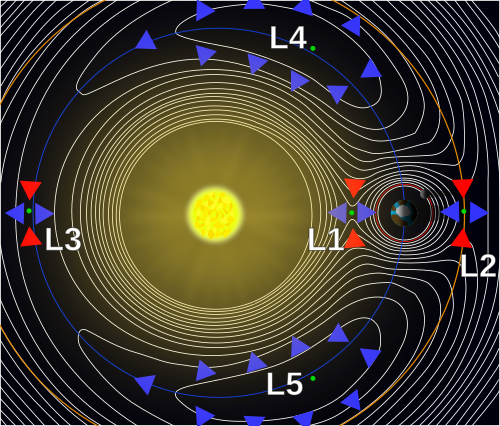 |
| Original found here. |
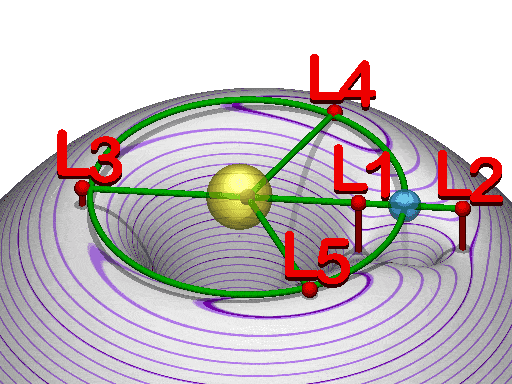 |
| Original found here. |
L2 is of particular interest since it is partially shielded from solar radiation by the Earth. It is 1,500,000 km away, almost four times the distance to the moon, and sits just outside full protection by the magnetic field.
The interesting thing about these points is that getting from one to another takes very little energy. A slight push in the right direction can put a payload with a large mass into a trajectory to end up at the next point. This makes the L-points ideal for space stations to route supplies and missions. Contrast this to the enormous cost of getting a pound of material up off the Earths surface to even low earth orbit.
In addition to moving toward or away from the system, in a complex way objects can "orbit" the Lagrangian points. Their orbits are actually controlled by the interplay of Earth and Sun gravities, but the end result is that they appear to orbit a point of empty space. The L-point orbits are complex because more than two objects are interacting and in motion at the same time. There are "halo" and "lissajous" orbits that are not "flat" in a plane like orbits we are used to thinking about but move in three dimensions. A neat example uses the moon to boost an object from Earth orbit out to orbit "around" L2.
In fact, this idea can be extended to include Lagrangian points of other planets in the solar system. If you can get to the Earth-Sun L2 you can get to any other plants Lagrangian points with very little energy, just with some nudges in the right direction. (With more energy you can get there faster by taking shortcuts through places with gravity/orbital forces to overcome.) A highly stylized conception from NASA of an interplanetary network is below.
 |
| Original found here. |
Steering away from Local
Usually the biggest hurdle in thinking about and discussing something is realizing that it exists in the first place. We can be completely blind to patterns all around us simply because we haven't identified them yet.
There is a pattern in traveling and living among different cultures that I'm trying to put my finger on. I'm not even sure what to call it. For example, I really like Ethiopian food and loved going to an Ethiopian restaurant in DC when we lived in Maryland. I have also traveled to Ethiopia a couple times in East Africa, but more than once when I am ordering food in Ethiopia they insist on bringing me something Italian like lasagna. There are several layers to this; making me "comfortable" with assumptions about food I would like (I look European and Italian is European); pride in showing me that they can make good lasagna in the restaurant and seeing what I think about it; but also there is something I am calling "steering away from local" for lack of a better phrase at the moment.
Here in Hawai'i fishing in the sea is a central part of Hawaiian life. For some reason, years ago, a freshwater lake was constructed near one of the ubiquitous military bases here on Oahu and stocked with bass, which I forgot about almost as soon as I heard about it. I was talking to a Native Hawaiian guy about taking T fishing from a boat. Of course I was thinking of going out in the ocean; I have never fished in the ocean from a boat before. He started talking about the stocked bass pond and how to get to it which threw me at first but then I realized he assumed I would want something "more like home" for fishing from a boat.
There are examples of this from when we lived in Germany too. In fact, I don't think I've ever lived in or visited a place where more assumptions (true or false) were made and applied to us (as a short cut for asking us what we thought) than in Germany. In Germany there is a weird view of what most Americans are like that comes from popular TV shows, biased news reports, and visiting NY city. Germans seemed genuinely surprised that I would be interested in having a garden plot, going hunting or fishing, learning local dialects, being involved in the community, etc. Instead I was directed toward the nearest city and/or fast food packed shopping mall with English language movie night or the English language section of the bookstore for what "we would be interested in."
These events seemed odd, as many things in daily life do, and usually I forget about it and move on. However, now that I have identified a common patterns I am keeping my eye out for more examples.
There is a pattern in traveling and living among different cultures that I'm trying to put my finger on. I'm not even sure what to call it. For example, I really like Ethiopian food and loved going to an Ethiopian restaurant in DC when we lived in Maryland. I have also traveled to Ethiopia a couple times in East Africa, but more than once when I am ordering food in Ethiopia they insist on bringing me something Italian like lasagna. There are several layers to this; making me "comfortable" with assumptions about food I would like (I look European and Italian is European); pride in showing me that they can make good lasagna in the restaurant and seeing what I think about it; but also there is something I am calling "steering away from local" for lack of a better phrase at the moment.
Here in Hawai'i fishing in the sea is a central part of Hawaiian life. For some reason, years ago, a freshwater lake was constructed near one of the ubiquitous military bases here on Oahu and stocked with bass, which I forgot about almost as soon as I heard about it. I was talking to a Native Hawaiian guy about taking T fishing from a boat. Of course I was thinking of going out in the ocean; I have never fished in the ocean from a boat before. He started talking about the stocked bass pond and how to get to it which threw me at first but then I realized he assumed I would want something "more like home" for fishing from a boat.
There are examples of this from when we lived in Germany too. In fact, I don't think I've ever lived in or visited a place where more assumptions (true or false) were made and applied to us (as a short cut for asking us what we thought) than in Germany. In Germany there is a weird view of what most Americans are like that comes from popular TV shows, biased news reports, and visiting NY city. Germans seemed genuinely surprised that I would be interested in having a garden plot, going hunting or fishing, learning local dialects, being involved in the community, etc. Instead I was directed toward the nearest city and/or fast food packed shopping mall with English language movie night or the English language section of the bookstore for what "we would be interested in."
These events seemed odd, as many things in daily life do, and usually I forget about it and move on. However, now that I have identified a common patterns I am keeping my eye out for more examples.
Subscribe to:
Comments (Atom)


